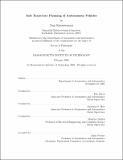| dc.contributor.advisor | Eric Feron, Jonathan P. How and Munther Dahleh. | en_US |
| dc.contributor.author | Schouwenaars, Tom | en_US |
| dc.contributor.other | Massachusetts Institute of Technology. Dept. of Aeronautics and Astronautics. | en_US |
| dc.date.accessioned | 2007-01-10T15:36:35Z | |
| dc.date.available | 2007-01-10T15:36:35Z | |
| dc.date.copyright | 2006 | en_US |
| dc.date.issued | 2006 | en_US |
| dc.identifier.uri | http://hdl.handle.net/1721.1/35298 | |
| dc.description | Thesis (Ph. D.)--Massachusetts Institute of Technology, Dept. of Aeronautics and Astronautics, 2006. | en_US |
| dc.description | This electronic version was submitted by the student author. The certified thesis is available in the Institute Archives and Special Collections. | en_US |
| dc.description | Includes bibliographical references (p. 153-163). | en_US |
| dc.description.abstract | This thesis presents a novel framework for safe online trajectory planning of unmanned vehicles through partially unknown environments. The basic planning problem is formulated as a receding horizon optimization problem using mixed-integer linear programming (MILP) to incorporate kino-dynamic, obstacle avoidance and collision avoidance constraints. Agile vehicle dynamics are captured through a hybrid control architecture that combines several linear time-invariant modes with a discrete set of agile maneuvers. The latter are represented by affine transformations in the state space and can be described using a limited number of parameters. We specialize the approach to the case of a small-scale helicopter flying through an urban environment. Next, we introduce the concept of terminal feasible invariant sets in which a vehicle can remain for an indefinite period of time without colliding with obstacles or other vehicles. These sets are formulated as affine constraints on the last state of the planning horizon and as such are computed online. They guarantee feasibility of the receding horizon optimization at future time steps by providing an a priori known backup plan that is dynamically feasible and obstacle-free. | en_US |
| dc.description.abstract | (cont.) Vehicle safety is ensured by maintaining a feasible return trajectory at each receding horizon iteration. The feasibility and safety constraints are essential when the vehicle is maneuvering through environments that are only partially characterized and further explored online. Such a scenario was tested on an unmanned Boeing aircraft using scalable loiter circles as feasible invariant sets. The terminal feasible invariant set concept forms the basis for the construction of a provably safe distributed planning algorithm for multiple vehicles. Each vehicle then only computes its own trajectory while accounting for the latest plans and invariant sets of the other vehicles in its vicinity, i.e., of those whose reachable sets intersect with that of the planning vehicle. Conflicts are solved in real-time in a sequential fashion that maintains feasibility for all vehicles over all future receding horizon iterations. The algorithm is applied to the free flight paradigm in air traffic control and to a multi-helicopter relay network aimed at maintaining wireless line of sight communication in a cluttered environment. | en_US |
| dc.description.statementofresponsibility | by Tom Schouwenaars. | en_US |
| dc.format.extent | 163 p. | en_US |
| dc.format.extent | 2311471 bytes | |
| dc.format.extent | 2307793 bytes | |
| dc.format.mimetype | application/pdf | |
| dc.format.mimetype | application/pdf | |
| dc.language.iso | eng | en_US |
| dc.publisher | Massachusetts Institute of Technology | en_US |
| dc.rights | M.I.T. theses are protected by copyright. They may be viewed from this source for any purpose, but reproduction or distribution in any format is prohibited without written permission. See provided URL for inquiries about permission. | en_US |
| dc.rights.uri | http://dspace.mit.edu/handle/1721.1/7582 | |
| dc.subject | Aeronautics and Astronautics. | en_US |
| dc.title | Safe trajectory planning of autonomous vehicles | en_US |
| dc.title.alternative | Safe trajectory planning of AV | en_US |
| dc.type | Thesis | en_US |
| dc.description.degree | Ph.D. | en_US |
| dc.contributor.department | Massachusetts Institute of Technology. Department of Aeronautics and Astronautics | |
| dc.identifier.oclc | 74811347 | en_US |
